
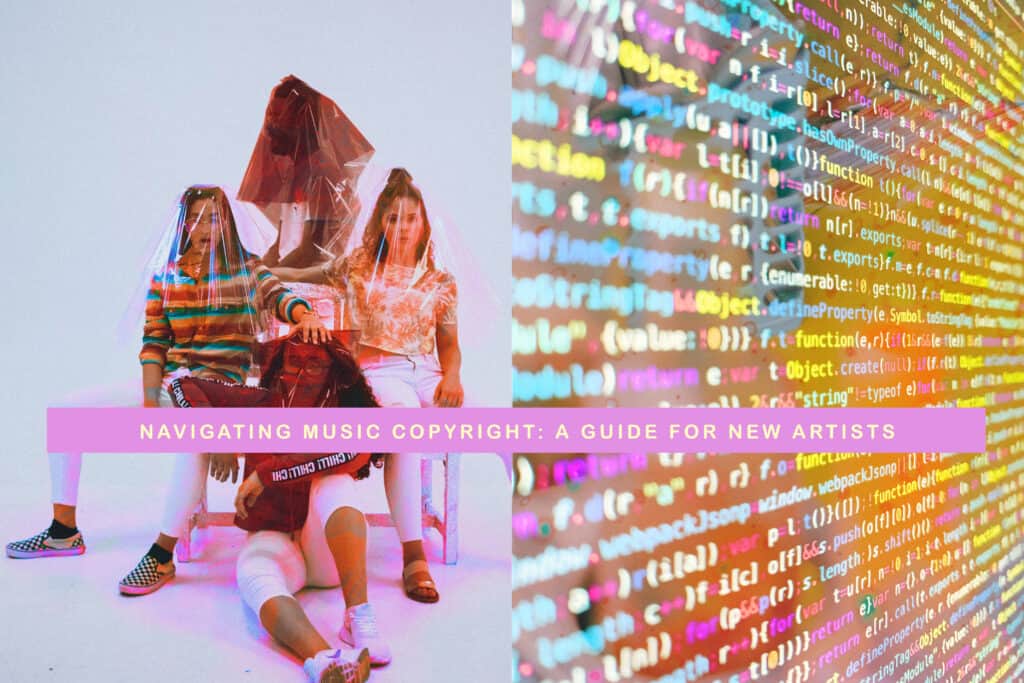
New artists need to understand music copyright to succeed in the industry. To protect your artistic creations and get recognized, it’s important to understand music copyright. This guide will teach you about music copyright and help you handle copyright issues.
Music copyright is the legal protection granted to creators of original music. It gives them exclusive rights to their creations. As a new artist, understanding music copyright is important for several reasons. You can use it to protect your music from being used without permission. You can also control how your music is shared and performed. Additionally, you can make money from your creative work.
Musical compositions, lyrics, and sound recordings are among the works that are protected by music copyright. Need to to know what elements of your music are covered under copyright law to ensure that your rights are safeguarded.
Securing music copyright involves taking certain steps to establish your ownership. Registering your music with the Copyright Office is a crucial step in protecting your rights and providing evidence of ownership. Knowing what copyright notices do can stop people from stealing your work and let others know your rights.
Music copyright owners have a range of rights that they can exercise. These include reproduction rights, distribution rights, performance rights, and the right to create derivative works. Understanding these rights is integral in managing and leveraging your music in the industry.
The concept of fair use plays a significant role in music copyright. You can use some copyrighted material without permission for specific purposes, like criticism or teaching. Understanding the factors considered in determining fair use can help you navigate situations where your music may be used without your explicit permission.
To avoid copyright infringement, it is crucial to obtain proper licenses for the use of music. Understanding the different types of music licenses and knowing when and how to obtain them is essential for ensuring that your music is used legally and that you are appropriately compensated for its usage.
In cases of copyright infringement, enforcement and remedies are available to protect your rights. Legal actions and penalties can be pursued against infringers. To protect yourself as a new artist, use contracts, monitor your music’s usage, and work with professionals in the industry. This will help prevent infringement.
This guide explores music copyright. It equips you with knowledge and tools to navigate copyright law. You can protect your creations and thrive as a new artist in the music industry.

Understanding Music Copyright is crucial for new artists to protect their creative work and avoid legal issues. Here are some key points to consider:
Understanding music copyright is vital for new artists to protect their creative works, receive recognition, and be compensated. By familiarizing themselves with the discussed key concepts above, artists can navigate the complex world of music copyright with confidence and safeguard their artistic endeavors.
Music copyright is a legal protection that grants rights to original musical works, encompassing compositions and lyrics. It is crucial for new artists to understand the concept of music copyright as it not only safeguards their rights but also controls the use and distribution of their music.
Music copyright safeguards original compositions, including melodies, harmonies, and arrangements. These compositions cannot be copied or used by anyone without permission.
In addition, lyrics are also protected by music copyright as intellectual property. No one else can use them without proper authorization.
Furthermore, sound recordings, which capture performances of the music, are also protected by music copyright. Artists have exclusive rights over their own recordings.
Securing music copyright is essential for new artists as it provides legal protection. Registering music with the Copyright Office serves as evidence of ownership and is valuable in legal disputes.
Copyright owners possess several rights under music copyright law. They have sole authority over the reproduction of their music, allowing them to make copies. They also have the power to control the distribution and sale of their music for financial benefit through distribution rights. Performance rights enable them to control public performances, including live concerts and broadcasts. Copyright owners have the right to create derivative works, such as remixes or adaptations.
Understanding fair use is important in the context of music copyright. Fair use allows limited use of copyrighted material without seeking permission, such as for educational purposes or criticism. Determining fair use depends on factors such as the purpose, nature, amount used, and effect on the market.
To avoid copyright infringement and comply with licensing requirements, new artists should obtain proper licenses for any use of copyrighted music. This includes obtaining licenses for public performances, synchronization licenses for audiovisual works, and mechanical licenses for reproducing and distributing music.
In the case of copyright infringement, copyright owners have the right to enforce their copyright and seek remedies, such as damages, injunctions, and seizing infringing copies.
Understanding music copyright is of utmost importance for new artists. It provides legal protection for their creative works, ensuring that their music is recognized as their intellectual property and preventing any unauthorized use or profiting from it. There are several reasons why comprehending music copyright is crucial for new artists:
1. Protecting creative works: Copyright grants new artists exclusive rights over their music, which encompasses original compositions, lyrics, and sound recordings. It empowers them to govern how their music is utilized, reproduced, distributed, and performed. This safeguard is vital for artists to maintain ownership and control over their creations.
2. Financial benefits: Copyright allows artists to derive monetary value from their music through licensing, royalties, and various income streams. By grasping copyright, artists can negotiate equitable deals with record labels, streaming platforms, and other stakeholders in the music industry. This ensures that they receive proper compensation for their hard work.
3. Preventing infringement: Understanding music copyright enables new artists to identify and prevent any unauthorized use of their music. It empowers them to take legal action against those who infringe upon their rights, seeking damages and potentially obtaining injunctions to halt the unauthorized use.
4. Building a professional reputation: Copyright protection enhances an artist’s credibility and legitimacy, showcasing their dedication and seriousness towards their career. When other professionals witness an artist’s strong comprehension of copyright, it heightens their professional reputation.
5. Collaborations and licensing opportunities: Knowledge of copyright allows artists to navigate collaborations and licensing agreements effectively. It assists them in comprehending ownership rights, revenue splits, and the terms of use for their music when working with others. This understanding opens doors to opportunities for exposure, promotion, and reaching new audiences.
6. Long-term career sustainability: By understanding music copyright, new artists can confidently navigate the intricate music industry. It empowers them to make well-informed decisions regarding contracts, licensing, and safeguarding their interests. This knowledge contributes to the long-term sustainability and success of their careers.
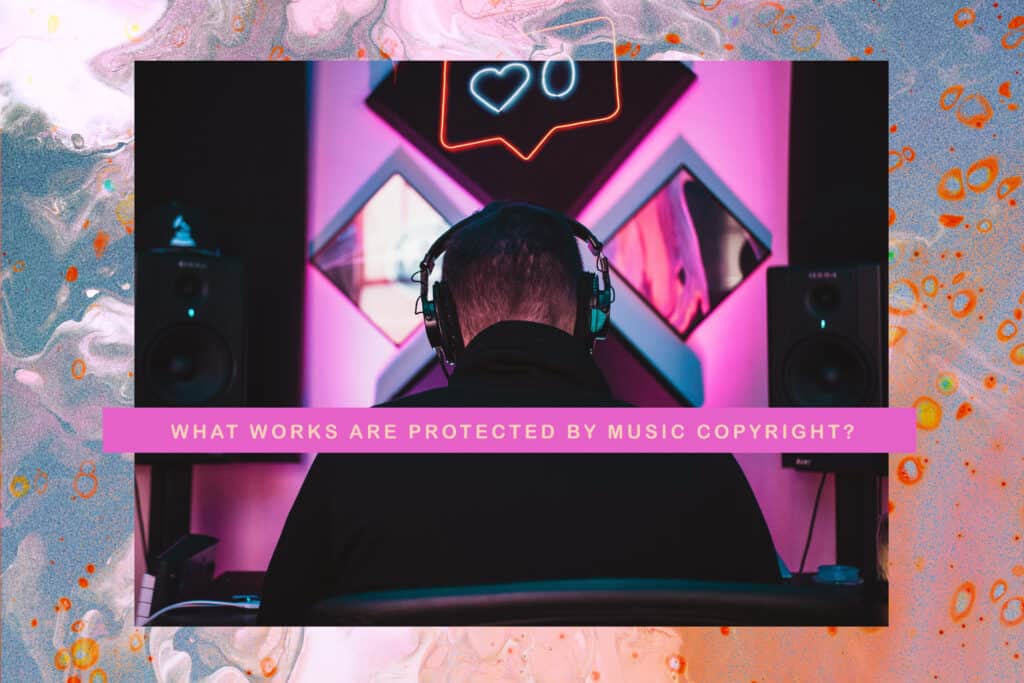
Music copyright is a crucial aspect for new artists to understand. So, let’s dig into what works are actually protected by this form of intellectual property. We’ll start by exploring the realm of original musical compositions, where the magic of melody and harmony comes to life. Then, we’ll delve into the significance of lyrics, the soul-stirring words that give songs their meaning. We’ll uncover the importance of sound recordings, capturing the essence of the artist’s musical creation. Get ready to discover the fascinating world of music copyright protection!
Original musical compositions play a crucial role in the music industry. They are created by talented songwriters and composers, giving birth to beautiful melodies and harmonies. Understanding the significance of these compositions is vital for aspiring new artists.
1. These unique musical creations form a musician’s identity, allowing them to express their creativity. They skillfully combine elements such as melody, harmony, rhythm, and meaningful lyrics.
2. Copyright protection ensures that creators have exclusive rights to their original work. This means that others cannot reproduce or perform these compositions without proper permission or a license. Securing copyright is essential for new artists as it safeguards their intellectual property and enables them to receive deserved recognition and compensation.
3. Original compositions hold substantial value in the industry. They can be recorded, performed, and licensed for various purposes, including use in movies and TV shows. They offer opportunities for collaboration and increase an artist’s visibility.
4. Artists have the opportunity to earn income through licensing and royalty agreements for their original compositions. This includes revenue from streaming platforms, radio play, live performances, and synchronization licenses for film and television.
5. The power of original compositions lies in their ability to move and inspire people, transcending cultural boundaries. By creating unique and captivating musical pieces, new artists can captivate audiences and cultivate a dedicated fan base.
In summary, original musical compositions are the heart and soul of the music industry. They allow artists to showcase their creativity, protect their work, and earn recognition and income. They have the power to touch people’s hearts and bring communities together.
Lyrics are a vital part of a song and are protected by music copyright. They are the words or text that are sung or spoken in a song. Original lyrics are considered creative works and are automatically protected by copyright when fixed in a tangible form. To provide additional legal protection, lyrics can be registered with the copyright office. Unauthorized use or reproduction of lyrics without permission from the copyright owner is infringement. Lyrics can be protected against unauthorized use in various ways, such as reproducing them in print, displaying them on websites, or using them in public performances. They can also be licensed for use by other artists, TV shows, movies, or advertisements.
The copyright owner of lyrics has the exclusive right to reproduce, distribute, perform, and create derivative works based on the lyrics. When using lyrics written by someone else, it is important to obtain proper licenses or permission to avoid infringement. Plagiarizing lyrics, which involves copying someone else’s lyrics without permission or giving credit, is also a violation of copyright laws.
Pro-tip: When writing lyrics, always strive to create original and unique content. Take inspiration from various sources but put your own creative spin on the words. Remember, obtaining proper licenses for lyrics you want to use or properly crediting the original songwriter is crucial to respect copyright laws and protect your own intellectual property.
Sound recordings, often referred to as audio representations of music or other sounds, play a vital role in the music industry. For new artists, it is crucial to comprehend the significance of these recordings as well as the measures to protect them.
Here are some key points to consider:
1. Definition: Sound recordings capture the performance of a musical composition, including vocals, instruments, and production elements. They are fixed audio representations of music or other sounds.
2. Copyright Protection: Most countries grant copyright protection to sound recordings. This protection gives the owner exclusive rights to reproduce, distribute, and publicly perform the recording.
3. Ownership: Typically, the copyright owner of a sound recording is the recording artist, record label, or producer. It is essential for new artists to understand their rights and the contractual agreements related to their recordings.
4. Licensing: When artists use sound recordings created by others, such as sampling or covering a song, they must obtain proper licenses. License agreements ensure the legal use of copyrighted recordings while providing fair compensation to the original creators.
5. Royalties: Owners of sound recordings earn royalties from various sources, including radio play, streaming platforms, and other public performances. Performance rights organizations collect and distribute these royalties to the copyright owners.
6. Piracy and Protection: Sound recordings are susceptible to piracy, which can lead to significant financial losses. Artists can protect their work by employing measures like watermarks or digital rights management (DRM) technologies.
7. Streaming and Digital Platforms: The advent of streaming services has made sound recordings more accessible to a broader audience. Artists should explore digital distribution opportunities and have a clear understanding of the terms and royalties associated with streaming platforms.
8. Copyright Duration: The duration of copyright protection for sound recordings varies from country to country. For example, sound recordings created on or after January 1, 1972, in the United States are protected for 95 years from publication or 120 years from creation, whichever is earlier.
Understanding the importance and legal aspects of sound recordings is indispensable for new artists. By respecting copyright laws, obtaining proper licenses, and taking measures to protect their work, artists can safeguard their recordings and ensure they receive the recognition and compensation they deserve for their creations.
Securing music copyright is a crucial step for new artists to protect their creative work. In this section, we’ll dive into two key areas: registering your music with the Copyright Office and understanding the role of copyright notices. Get ready to learn how to safeguard your musical creations and ensure your rights as an artist are respected.
Registering Your Music with the Copyright Office is crucial for new artists to protect their work and secure legal rights. Here is a step-by-step guide to register your music:
1. Gather your materials: Collect the musical composition, lyrics, and sound recordings for registration.
2. Create an account: Visit the Copyright Office website to create an account for online access.
3. Complete the application: Fill out the provided application form accurately and provide detailed information about your music, including the title, author(s), date of creation, and other relevant details.
4. Pay the registration fee: Check the current fee schedule and submit the payment along with your application.
5. Submit your materials: Upload the required musical composition, lyrics, and sound recordings according to the instructions on the website.
6. Keep a copy of your registration: Once your application is accepted, the Copyright Office will issue a registration certificate. Keep a copy as proof of your registered copyright.
Registering your music offers several benefits. It establishes a public record of ownership, making it easier to prove your rights in case of infringement. It also enables you to file a lawsuit and seek damages for copyright infringement. Registration is a prerequisite for certain legal remedies such as statutory damages and attorney’s fees.
Remember, registering your music with the Copyright Office is crucial for protecting your intellectual property. By following these steps, you can ensure that your music is legally protected, and you have the necessary rights to control its use and distribution.
Copyright notices are crucial for protecting the rights of music copyright owners. They indicate that the work is protected by copyright and using it without permission may lead to legal consequences. It’s important for new artists to understand the role of copyright notices to safeguard their creations and prevent infringement.
1. Notifying ownership: Copyright notices state the name of the copyright owner or entity holding the rights to the music. This establishes ownership and allows others to contact the owner for permission or licensing.
2. Deterrence: Including a copyright notice on music releases, websites, or promotional materials deters potential infringers. It sends a strong message that the work is protected and discourages unauthorized use.
3. Establishing infringement: In infringement disputes, a copyright notice can be used as evidence that the owner asserted their rights. It strengthens legal claims and facilitates enforcement actions.
4. Providing contact information: Copyright notices often include contact information, such as an email address or website, allowing interested individuals to seek authorization or licensing. This promotes transparency and proper use of copyrighted works.
5. International recognition: Copyright notices are recognized internationally, ensuring the owner’s rights are respected in different jurisdictions. It prevents confusion and clarifies that the music is not in the public domain.
To effectively use copyright notices, new artists should make them clearly visible and place them in prominent locations, such as album covers, websites, and digital music platforms. It is also essential to include the correct copyright symbol (©), the copyright owner’s name, and the year of first publication.
For further advice on copyright protection and maximizing your rights as a new artist, consult the comprehensive guide “Navigating Music Copyright: A Guide for New Artists.” This resource provides valuable insights and practical suggestions to enhance your understanding of copyright matters in the music industry.
As we explore the world of music copyright, it’s crucial to understand the rights that music copyright owners hold. From reproduction and distribution rights to performance rights and derivative works, each sub-section unveils a unique facet of these rights. Get ready to uncover the power and scope that copyright owners possess, ensuring their control over the commercial exploitation, protection, and recognition of their musical creations. Let’s dive in and unravel the intricacies of music copyright ownership.
Reproduction rights are a crucial aspect of music copyright and grant the owner the exclusive right to duplicate their work. Here is a breakdown of the key information about reproduction rights in music:
Definition: Reproduction rights refer to the exclusive right of the copyright owner to duplicate their original musical composition, lyrics, or sound recordings.
Ownership: The reproduction rights are initially held by the individual or entity that created the music, such as the songwriter, composer, or producer. In some cases, these rights may be transferred to a music publisher or record label through contractual agreements.
Scope: Reproduction rights cover various forms of duplication, including physical copies such as CDs, vinyl records, and cassette tapes, as well as digital formats like MP3s or streaming services.
Limitations: While reproduction rights grant exclusive control over copying and distribution, there are limitations to consider. Fair use exceptions, for instance, may allow others to use a portion of a copyrighted work for purposes such as criticism, comment, or educational purposes.
Infringement: Unauthorized reproduction of copyrighted music without obtaining proper licenses or permissions constitutes infringement. This includes making unauthorized copies for sale or distribution.
Enforcement: If someone infringes on your reproduction rights, you can take legal action to enforce your rights. This may involve sending cease and desist letters, filing lawsuits, and seeking damages.
Pro-tip: As a new artist, it is crucial to understand and protect your reproduction rights. Register your music with the copyright office to establish a legal record of your ownership. Consider using digital rights management (DRM) technologies for digital distribution to prevent unauthorized copying and piracy.
The distribution rights are essential for music copyright ownership. These rights determine the control an artist or copyright owner has over the distribution and sale of their music. Here is a table that highlights the various aspects of distribution rights:
| Aspect | Description |
| Definition | Distribution rights refer to the exclusive right of the copyright owner to reproduce, distribute, and sell copies of their music to the public. |
| Scope | Distribution rights cover physical copies of music, such as CDs, vinyl, and tapes, as well as digital distribution through online platforms, streaming services, and downloads. |
| Exclusive Right | The copyright owner has the sole authority to determine how and where their music is distributed. They can choose to sell their music through specific retailers, online platforms, or directly to consumers. |
| Limitations | While distribution rights grant exclusive control, there may be limitations based on licensing agreements or contracts with distributors. Artists may choose to enter into agreements with record labels or distributors to handle the marketing and distribution of their music. |
| International Distribution | Artists with international recognition need to consider distribution rights in different territories. They can enter into licensing agreements with local distributors or use digital platforms to reach a global audience. |
| Enforcement | If anyone infringes on an artist’s distribution rights by unauthorized reproduction or distribution of their music, the copyright owner has the legal right to take action and seek damages, including injunctions, royalties, or compensation. |
Understanding distribution rights is crucial for new artists as it allows them to have control over how their music is disseminated to the public and ensures they receive fair compensation for their work. It is important for artists to explore different distribution channels and consider the best approach for their music and audience. Properly managing distribution rights can help artists reach a wider audience, maximize their income, and protect their creative work from unauthorized use or distribution.
The performance rights of music copyright are crucial for new artists. Understanding these rights helps artists protect their work and ensure fair compensation for performances. Here are key aspects of performance rights:
– Performance rights encompass the right to publicly perform a copyrighted musical composition. This includes live performances, concerts, and playing recorded music in public venues.
– The copyright owner has exclusive control over performance rights.
– Artists often need to obtain a license from performance rights organizations (PROs) like ASCAP, BMI, or SESAC to exercise performance rights. These organizations collect fees from venues and distribute royalties to copyright owners.
– Performance rights also apply to digital performances, such as streaming on websites, social media platforms, and online radio.
– Covering a song by another artist may require performance rights. Artists must obtain licenses to legally perform and record copyrighted songs.
To protect their performance rights and maximize earnings, new artists should consider the following suggestions:
– Register their music with a PRO to properly track performances and collect royalties.
– Understand the licensing process and obtain the appropriate licenses for public performances or digital streaming of copyrighted music.
– Join industry organizations for help with managing performance rights and advocating for fair compensation.
– Stay informed about changes in the music industry, particularly in streaming platforms and digital performances, to be aware of new opportunities and challenges in protecting rights.
By understanding and exercising their performance rights, new artists can protect their creative work, receive fair compensation for performances, and build a successful music career.
Edited
Derivative Works
A derivative work is a new piece of work that is derived from an existing copyrighted work in the context of music copyright. It incorporates elements from the original work while presenting new creative elements.
Derivative works in music can take various forms such as remixes, adaptations, arrangements, or translations of an original musical composition. These works are based on the original composition but have been modified to create a distinct piece of music.
Here is a table that provides a clear overview of different types of derivative works:
| Type of Derivative Work | Description |
|---|---|
| Remixes | Remixes involve recombining elements from an original song to create a new version with different beats, vocals, or instrumentals. |
| Adaptations | Adaptations involve modifying an original composition to fit a different musical style, genre, or instrumentation. |
| Arrangements | Arrangements involve reinterpreting an original composition by changing the harmonies, rhythms, or melodies while retaining the basic structure of the piece. |
| Translations | Translations involve reimagining the lyrics of an original composition in a different language while keeping the melody intact. |
Permission from the copyright owner of the original composition is required for these derivative works. Obtaining a license or clearance is crucial to avoid infringing on the rights of the original copyright holder.
It is important to note that while derivative works incorporate elements from existing copyrighted works, they are still considered new works and are protected under copyright law as their own entities. This means that the creator of a derivative work also holds copyright over their contribution to the overall piece.
Fact: Derivative works have become popular in the music industry, with remixes and adaptations often serving as creative collaborations between artists and offering fresh interpretations of familiar songs.
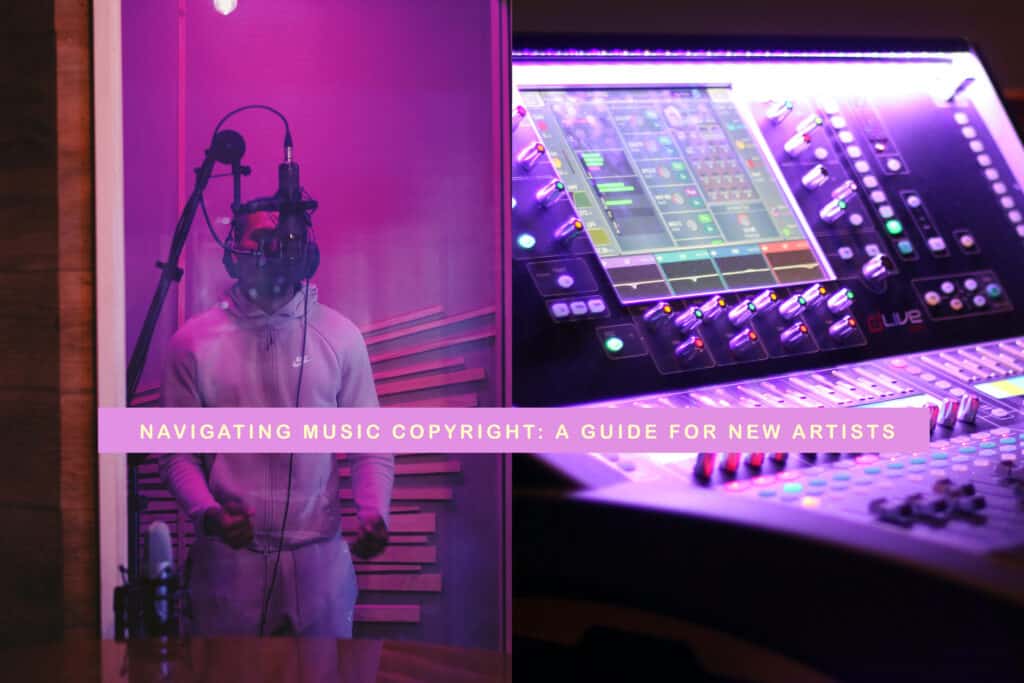
Delve into the realm of fair use and music copyright, uncovering the ins and outs of this critical aspect for new artists. Get ready to explore the concept of fair use and discover the factors that come into play when determining the fair use of music. Brace yourself for a journey through the legal intricacies, as we navigate the fine line between creativity and copyright protection in the music industry.
Fair use is a crucial aspect of music copyright. Understanding the concept of fair use allows for the limited use of copyrighted material without permission from the copyright owner. This includes purposes such as criticism, commentary, news reporting, teaching, scholarship, or research.
1. Fair use allows for the use of copyrighted material without permission, as long as it serves a different purpose from the original work. For example, using a small portion of a song for a parody or incorporating copyrighted music into a documentary to illustrate a point.
2. Four factors determine fair use:
a) The purpose and character of the use: Understanding the concept of fair use shows that it is more likely for nonprofit, educational, or transformative purposes.
b) The nature of the copyrighted work: Understanding the concept of fair use shows that it is more likely for factual or published works.
c) The amount and substantiality of the portion used: Understanding the concept of fair use shows that it is more likely when using a small, insignificant portion.
d) The effect of the use on the potential market for the copyrighted work: Understanding the concept of fair use shows that it is less likely if it harms the market value of the original work.
3. Fair use is a legal doctrine, but it is not a guaranteed defense against copyright infringement. Understanding the concept of fair use shows that determining fair use can be complex and usually decided on a case-by-case basis. It is important to consult legal professionals experienced in copyright law to determine if your use qualifies as fair use.
By understanding the concept of fair use, new artists can navigate copyright law more effectively. It allows them to incorporate elements of existing music into their own work for creative purposes, without infringing on copyright owners’ rights. However, fair use is not a blanket permission to use any copyrighted material, and caution should be exercised to avoid legal issues.
| Fair Use Factor | Description |
| Purpose and Character of the Use | This factor examines if the music is transformative or a replication of the original work. Transformative uses, like commentary, criticism, or parody, are more likely to be fair use. |
| Nature of the Copyrighted Work | This factor considers the creative nature of the original work. Fair use is easier to establish for factual or non-fictional works compared to highly creative musical compositions. |
| Amount and Substantiality of the Portion Used | The extent to which the copyrighted music is used is important. Using a small portion that does not capture the essence of the original work is more likely to be fair use. Using a substantial portion or the most recognizable parts may weigh against fair use. |
| Effect on the Market for the Original Work | This factor evaluates the potential impact of the use on the market value or potential market for the original work. If the use of the music negatively affects the market or potential income for the copyright owner, it is less likely to be fair use. |
Courts consider these four factors when determining fair use of music. Each case is assessed on its individual merits, and no single factor is determinative. The purpose and character of the use, whether the work is transformative, the nature of the copyrighted work, the amount used, and the effect on the market are all taken into account.
For example, if a new artist uses a small portion of a popular song to create a parody that provides social commentary, it may be considered fair use. Using the entirety of a copyrighted song as the main feature in a new track for commercial purposes is less likely to be considered fair use.
New artists must understand these factors to navigate the complex landscape of music copyright. By knowing the boundaries and limitations of fair use, artists can avoid legal issues and respect the rights of copyright owners.
In a true story, a young musician named Lisa wanted to create a cover version of a well-known song for her YouTube channel. She carefully considered the fair use factors and decided to use a small portion of the original song in a transformative manner. Lisa added her own unique elements, such as changing the tempo and incorporating her own lyrics. As a result, her cover version was considered fair use and received positive feedback from viewers. Lisa’s understanding of the factors in determining fair use allowed her to create her own creative interpretation without infringing on the copyright of the original song.
Steering clear of copyright infringement and understanding licensing is crucial for new artists in the world of music. Discover the significance of obtaining proper licenses for music use, and learn how to shield yourself against potential infringement cases. Unveil the secrets of protecting your artistic endeavors while navigating the complex music industry. Get ready to dive into a world where compliance and protection go hand in hand, empowering you to thrive as a new artist. Let’s get started!
Obtaining proper licenses for music use is crucial for artists to protect their work and avoid copyright infringement. Here is a step-by-step guide to obtaining the necessary licenses:
1. Determine the type of license needed: Different types of licenses exist for music use, including synchronization licenses for music in film or TV, mechanical licenses for music reproduction on CDs or streaming platforms, and performance licenses for live performances. Identify which license is applicable for your specific use.
2. Research the rights holder: Find out who owns the rights to the music you want to use. This could be the original artist, the songwriter, or a music publisher. Contact them to inquire about licensing and determine the terms and fees.
3. Negotiate the terms: Once you have identified the rights holder, negotiate the license terms. This includes details such as the license duration, authorized territories for music use, and the royalty or fee to be paid.
4. Obtain written permission: Get the agreement in writing to ensure clarity and avoid any future misunderstandings or disputes. Make sure both parties sign the licensing agreement.
5. Pay the required fees: Honor your agreement by paying the agreed-upon fees or royalties to the rights holder. Keep records of the payments for documentation purposes.
6. License renewal: If your use of the music extends beyond the original license duration, make sure to renew the license before it expires. Failure to do so can result in copyright infringement claims.
7. Comply with usage restrictions: Use the licensed music strictly within the authorized scope and adhere to any usage restrictions specified in the licensing agreement.
A cautionary tale that underscores the importance of obtaining proper licenses for music use involves an independent filmmaker who used a popular song in their film without permission. Despite believing that their small-scale production would go unnoticed, the rights holder discovered the unauthorized use and sued for copyright infringement. The filmmaker faced substantial fines and had to recall and revise their film, leading to significant financial and reputational damage. This story serves as a reminder to respect music copyright and obtain proper licenses to avoid legal consequences.
As a new artist, it is important to protect yourself against infringement to safeguard your original work and creative expression. Here are some steps you can follow to achieve this:
In 2000, musicians Robin Thicke and Pharrell Williams were accused of infringing on Marvin Gaye’s song “Got to Give It Up” with their hit single “Blurred Lines.” This case highlighted the importance of understanding copyright and avoiding the unintentional use of elements resembling existing copyrighted material.
Enforcement and Remedies for Music Copyright Infringement
To protect your original work from music copyright infringement, it is important to understand the available enforcement and remedies. Consider the following key points:
1. Legal Action: If someone infringes upon your music, you can take legal action against them. File a lawsuit to seek damages for the unauthorized use of your copyrighted work.
2. Cease and Desist Letters: Before resorting to legal action, start by sending a cease and desist letter. This letter demands that the infringing party immediately stops using your music or face legal consequences.
3. Injunctions: In urgent cases of infringement, you can request a court-issued injunction. An injunction legally prevents the infringing party from continuing to use your copyrighted music.
4. Damages: If you win a copyright infringement case, you may be entitled to monetary damages. The amount of damages awarded depends on factors such as the extent of the infringement, the profits made by the infringing party, and the actual damages suffered.
5. Statutory Damages: In some cases, copyright holders may be eligible for predetermined statutory damages set by the law. These damages do not require proof of actual monetary loss and can range from $750 to $30,000 per infringing work.
6. Criminal Charges: In severe cases of copyright infringement, such as commercial piracy or intentional distribution of copyrighted music, law enforcement may pursue criminal charges. Criminal penalties can include fines and imprisonment.
7. Digital Millennium Copyright Act (DMCA): The DMCA provides a way for copyright holders to protect their work in the digital age. It allows for the removal of infringing content from online platforms and gives copyright holders the ability to issue takedown notices.
Fact: The music industry lost an estimated $2.7 billion in global revenue due to music piracy in 2020, according to a study by the International Federation of the Phonographic Industry (IFPI).
By obtaining a copyright for your music, you gain exclusive rights to monetize your intellectual property. This means you can control how your music is used and collect royalties from its distribution, performances, and other income sources.
No, the concept of the “poor man’s copyright,” involving mailing a sealed copy of your music to yourself, does not provide the same level of protection as official registration. To fully protect your music, it is essential to register it with the U.S. Copyright Office or use a reliable copyright registration service.
To register your music copyrights, you need to follow these steps:
There are two primary types of music copyright:
Copyright is automatically attached to your music as soon as it is written. Officially copyrighting your music through registration with the U.S. Copyright Office provides additional legal protection and benefits. Although not necessary, it is highly recommended to register your music to strengthen your rights and increase your legal leverage.
To prove ownership of your music, you can timestamp it using various methods:



We know how music marketing is challenging. Use our music promotion services to build and grow your audience today!
Artists from all around the world use our Spotify promotion services. With one of the best and safest promotion companies in the industry, you can purchase Spotify plays and raise your social media accounts.
Want your videos to get the attention they deserve? Stand out from the crowd with our YouTube promotion packages. Increase the number of people who watch your videos, and grow followers on your YouTube channel.
With a tailored strategy to increase your audience, we help you form a vivid presence on SoundCloud. We do that, by promoting your content, boosting your socials, and keeping in check your SoundCloud insights.
TikTok is a merry mix of people from all over the world and a home to many musicians for interacting with their fans, making it a great place to share and promote new music. Sign up with us and let us help you promote music on TikTok.
We understand how artists feel after launching an Instagram account: getting new followers can be really challenging. With our social promotion for Instagram, we help you grow your followers and increase engagement on your posts.
When it comes to music promotion, Facebook can prove to be a very powerful tool! With billions of users worldwide, it’s a great way to spread the word on new content and promote yourself in multiple communities at once!

We are an European company specialized in music production & promotion. Made with ♥ by a bunch of wonderful people from Switzerland, Netherlands, and Spain.
Songlifty, make your music stand out
© 2025 SongLifty, powered by SongLifty. All Rights Reserved.
[email protected] | +372 618 8225 | Terms & Conditions | Privacy Policy
We are in no way affiliated with, endorsed by, or connected to Spotify or any other social network.